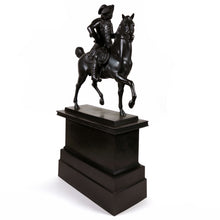A Berlin Ironware Equestrian Figure of Frederick the Great of Prussia, 1820
SOLD
Tax included.
Adding product to your cart
Measurements: Height: 64cm (25in)
Patinated iron. Equestrian figure of Frederick looking left, modelled in uniform wearing the breast star of the Order of the Black Eagle and tricorne hat.
The present figure was most probably produced at Royal Prussian iron foundries in Berlin. During the Napoleonic Wars the use of Prussian ironware for decorative objects took on a patriotic significance as a symbol of resistance to the French occupation in the wake of military defeat. By the early to mid 19th century the Prussian foundries used the material for objects normally produced in bronze or marble in furtherance of strong patriotic sentiments in both public and domestic domains.
Frederick the Great attracted the great thinkers of Enlightenment Europe to his court while establishing Prussia as a dominant military power. As a youth Frederick was a talented musician, a lover of philosophy and poetry, and an admirer of the French, whose language and culture would deeply mark his future reign. These interests infuriated his militaristic father and in 1730 Frederick attempted to run away to England, but the plot was foiled and Frederick imprisoned. His father not only had his main accomplice beheaded, but forced Frederick to watch. After King Frederick William I’s death in 1740, Frederick II, later the Great, stunned Europe by launching a surprise invasion of of Silesia, which then belonged to Habsburg Austria. This action triggered the War of the Austrian Succession, which lasted eight years and brought Frederick’s diplomatic and military skills to the fore. The Peace of Aachen ended the conflict in 1748 and formally ceded Silesia to Prussia, consolidating Prussia as a major European power.
Frederick further combined his military success with the French ideals he had absorbed through his education, establishing the model for enlightened despotism in Europe.
In the late 1740s Frederick began building Sanssouci, his extravagant summer palace in Potsdam, near Berlin. Frederick envisioned his estate as a Versailles for Berlin, a place for the enjoyment of the arts and the exploration of the latest developments in Enlightenment thinking. In due course Intellectuals arrived from all over Europe, causing Louis XV of France to declare “One more madman in the Prussian court and one less in mine.” Voltaire was undoubtedly the star of Frederick’s court but in 1753 they fell out. Frederick threw himself back into military pursuits. The ensuing Seven Years’ War (1756-1763) had major global ramifications that extended to North America and India. At first Frederick won resounding victories, defeating France and Austria at Rossbach in 1757. After reverses that fully tested Prussian resilience Frederick and his British ally emerged victorious, with Prussia’s standing in Europe was considerably enhanced.
Thereafter Frederick kept faith with his Enlightenment ideals until the end of his reign. In his ‘Essay on the Forms of Government’ (1777), he argued that a prince ‘is merely the principal servant of the State. Hence, he must act with honesty, wisdom, and complete disinterestedness in such a way that he can render an account of his stewardship to his citizens.’ An unabashed dog lover, Frederick II is credited with coining the phrase ‘man’s best friend’.
Use left/right arrows to navigate the slideshow or swipe left/right if using a mobile device








